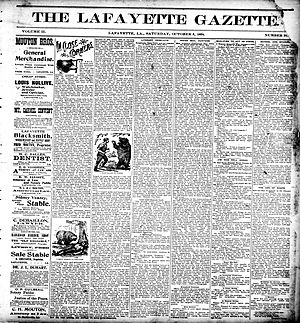History of Lafayette, Louisiana facts for kids
Lafayette, Louisiana, and the areas around it, have a rich mix of cultures. You'll find influences from Native American, African American, English, French, and Spanish traditions. This city is located in a part of Louisiana known as South Central Louisiana. The Vermilion River flows right through the city. Today, Lafayette is a key part of Acadiana, a region famous for its unique culture.
Contents
Early History of Lafayette
The very first people to live in this area were the Atakapa Native American tribes. They built several burial mounds, which are like ancient graves, along the Vermilion River and Bayou Teche. These mounds show us that people lived here a very long time ago.
Acadians Settle in the Area
The earliest records show this area was called the Atakapa and Opelousas districts. These names came from the local Native American tribes. Before 1765, not many Europeans lived here. Most were trappers or people who traded goods secretly.
By 1765, a group of French-speaking people called Acadians started arriving. They had been forced to leave their homes in Nova Scotia by the British. This event is known as the expulsion. Many Acadians arrived in New Orleans. The Spanish governor of the territory then helped them settle in the Lafayette area. They found new homes in places like St. Martinville and Opelousas.
Both French and Spanish leaders gave land freely to these new settlers. The land was usually along the bayous, like Carencro and Vermilion. Two of the first settlers were Andrew Martin, Jean Mouton, and Marin Mouton. Later, in 1805, a part of Louisiana was named Attakapas County. This happened when Governor William C. C. Claiborne created new counties.
Founding of Vermilionville
By 1812, Attakapas County was divided into two new areas: St. Martin Parish and St. Mary Parish. The village that would later become Lafayette was first planned in 1821. It was laid out by Jean Mouton and a surveyor named John Dinsmore, Jr. They named it "St. Jean du Vermilionville." Over time, the name was shortened to "Vermilionville." The town's borders were officially set in 1836 and then made larger in 1869.
Alexandre Mouton, Jean Mouton's son, was born in Lafayette in 1804. He grew up to become a very important person. He served as a U.S. Senator and was even the Governor of Louisiana from 1843 to 1846.
During the American Civil War, a battle took place near Vermilionville. On April 17, 1863, the Battle of Vermilion Bayou was fought. This was one of several battles between the Union Army led by Major General Nathaniel Prentice Banks and the Confederate States Army led by Major General Richard Taylor.
Lafayette Gets Its Name

In 1823, the Louisiana legislature divided St. Martin Parish. They created a new area called Lafayette Parish. This new parish was named after General Lafayette. He was a French hero who helped America win its independence. People were very excited about his visit to the United States.
However, the city itself kept the name Vermilionville for a while. This was because another town, a suburb of New Orleans, was already named Lafayette. But in 1884, that suburb became part of New Orleans. So, Vermilionville was finally able to change its name to Lafayette.


